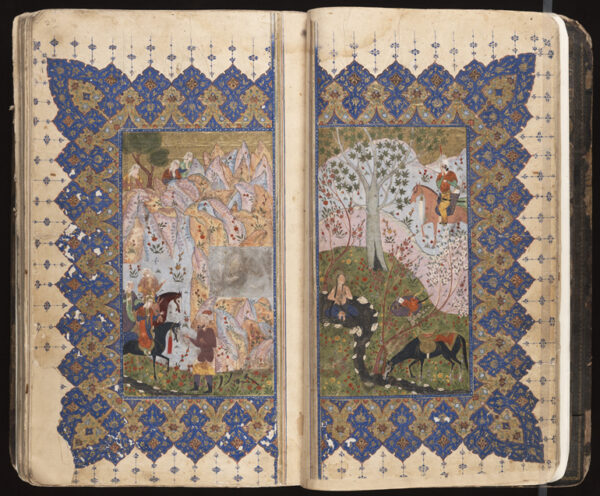It is a common belief that Islam forbids art that shows the human figure, but the issue is more nuanced. Depictions of the Prophet Mohammed are taboo and socially unacceptable. A proliferation of images of the prophet in comics, newspapers, contests and other media has created extensive controversy in the United States and beyond in the last few years. Debates have surged over the issues of freedom of speech, blasphemy, and unnecessary provocation of religious sensitivities. While the images are offensive to some Muslims, those on the other side bristle at the idea of being restrained by what they see as irrational religious doctrine. Just because someone can create a cartoon of Muhammad for the sole purpose of drawing ire, is it morally right to do so? At the root of the issue is strict adherence to a core tenet of Islam: the worship of God alone. Pictures of the prophet are thought to promote idolatry which is a clear contradiction of the oneness of God. Therefore, depictions of Mohammed, who is a messenger and not a representation of God, are seen as profane and insulting to Muslims. Instead, Islam uses other art forms as adornment such as calligraphy and intricate tile work.
There is, in fact, a rich tradition of representational art featuring animals, flowers, people, nature, and functional objects from books and teapots to horse carriages and buildings, as well as mythical creatures such as griffons and dragons. Representational art is especially prominent in Islamic book paintings, called miniatures. Indeed, they are used in a wide array of manuscripts, from scientific works to historical accounts and poems.
CREATING A MANUSCRIPT:
Manuscripts were created by teams of highly specialized – and usually anonymous – artists in libraries, schools and workshops. They date back to the first centuries of the Islamic calenda, which began in 622 CE. The production of such manuscripts was very time-consuming and costly, and as a result only the wealthy could afford them.
Creating a manuscript required several steps. First, a librarian had to determine the layout of each page and decide which scribes and artists he would need for the particular project. Calligraphers would then press lines into the paper and transcribe the text using ink and a reed pen.
Once this phase was completed, the manuscript would be handed over to several artists who would illustrate the text using mixtures of gold, lapis lazuli and other ground minerals. They were usually overseen by a master artist who was in charge of the overall composition of the miniatures and the most difficult illustrations. Other artists added illuminations as decorative details to the text, especially around the chapter headings, section breaks, borders and frontispieces.
Finally, the pages were sewn together and attached to a protective cover made of wood, leather or paper. The end result of a manuscript usually represents the collaborative efforts of a whole team of artists, scribes and bookbinders.
CALLIGRAPHY:
Calligraphy is considered to be one of the most important elements of Islamic art because of its essential role in transmitting the word of God in the Quran, the Muslim holy book. Literally meaning “beautiful writing,” calligraphy is a symbol of beauty and power and can found on every possible medium from manuscripts to pottery and even buildings.
The Arabic script is used in calligraphy because the Quran was revealed to the Prophet Muhammad in Arabic. Written from right to left and containing 28 letters, its fluid style and flexibility allows it to be manipulated into a variety of shapes and styles. Among the most important and widespread are the Kufic, Naskhi and Thuluth scripts. Here is an example of zoomorphic calligraphy;

ILLUMINATIONS:
Geometric, floral and abstract motifs are another major characteristic of Islamic art. Not only are they found in manuscripts in the form of illuminations, but we can also see them decorating the facades of palaces and mosques (such as the arabesque). Some believe that these complex and repetitive designs are used as a reminder of the infinite nature of God.
Illuminations are used to bring attention to the first page, chapter headings, and section breaks of a manuscript. Since it is prohibited to use figural representations to decorate the Quran, illuminations are often used instead. The most common shape used is the rectangle, though squares and circles can also be found.

MINIATURES:
Studying miniature paintings allows us to understand the richness and diversity of Muslim artistic production, and to examine the aesthetic values, social life and stories of the cultures that produced them.
Some of the earliest surviving miniatures are from Baghdad and date to around 1000 AD. By 1200, this art form had spread to most of the Islamic world. Miniature painting was particularly highly developed among the Ottomans, Safavids, and Mughals, three empires ruling in the Near and Middle East, greater Iran and South Asia, respectively.
SHORT HISTORY OF PERSIAN MINIATURES:
Persian miniature painting developed side by side with the emergence of some of the greatest Persian literary works, most notably the Shahnamah (Book of the Kings) dating from 1000 CE enumerating the different dynasties of Persia since the beginning of the world. Later, in the 12th Century, the poet Nizami wrote a collection of five romantic poems called Khamsa (literally meaning “five”), which were extremely popular and copied throughout the Islamic world.
These influential works gave rise to some of the best miniature painting schools and each had its own unique style and influence. Among these, the Shiraz, Tabriz and Herat schools were the most prominent.

